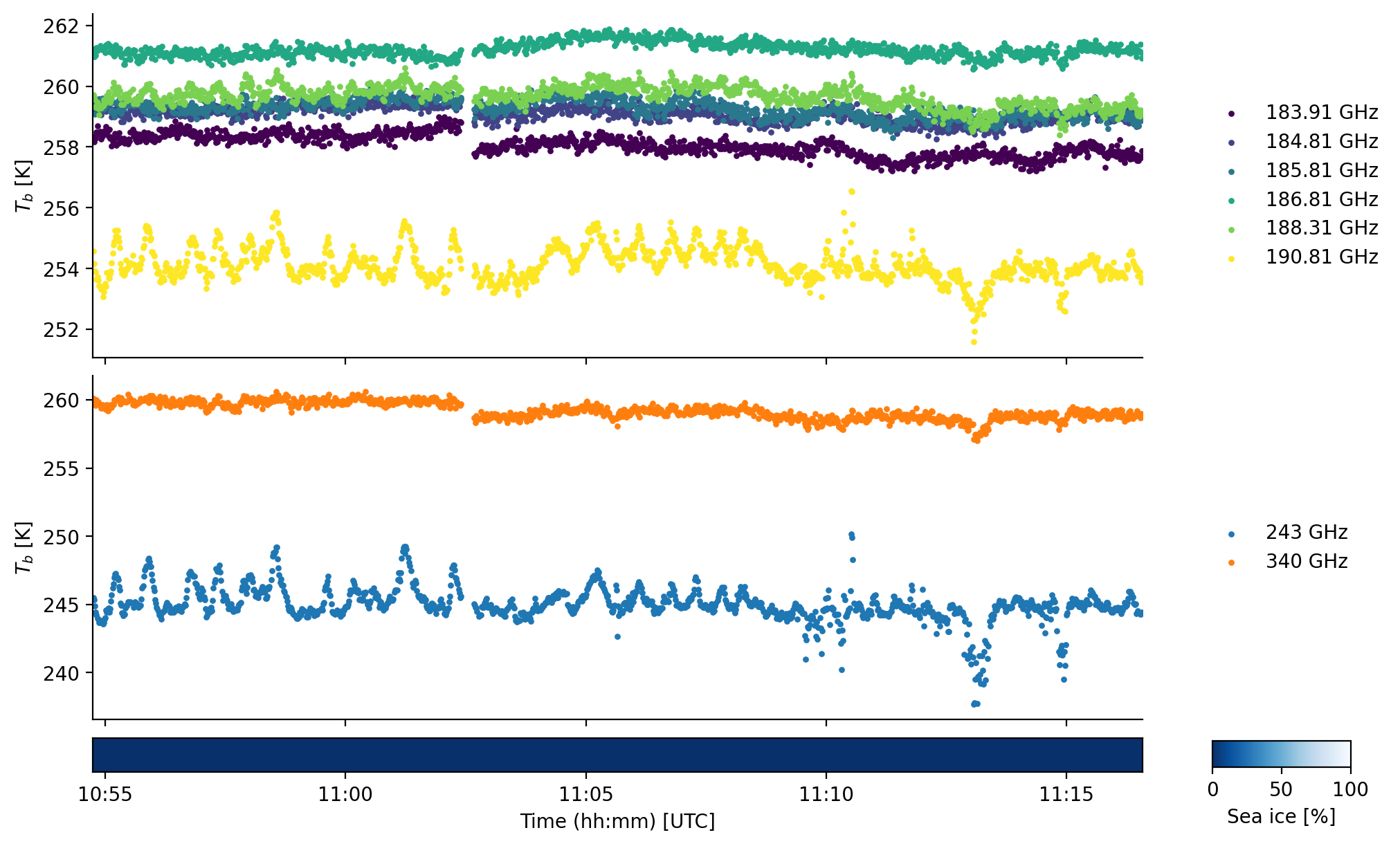MiRAC-P#
The following example presents the nadir passive microwave radiometer MiRAC-P. The Microwave Radar/Radiometer for Arctic Clouds - passive (MiRAC-P) was installed during ACLOUD and AFLUX. During MOSAiC-ACA, passive microwave observations are conducted by the HATPRO instrument.
More information on MiRAC can be found in Mech et al. (2019). If you have questions or if you would like to use the data for a publication, please don’t hesitate to get in contact with the dataset authors as stated in the dataset attributes contact or author.
import os
from dotenv import load_dotenv
load_dotenv()
# local caching
kwds = {'simplecache': dict(
cache_storage=os.environ['INTAKE_CACHE'],
same_names=True
)}
import ac3airborne
cat = ac3airborne.get_intake_catalog()
datasets = []
for campaign in ['ACLOUD', 'AFLUX']:
datasets.extend(list(cat[campaign]['P5']['MiRAC-P']))
datasets
['ACLOUD_P5_RF04',
'ACLOUD_P5_RF05',
'ACLOUD_P5_RF06',
'ACLOUD_P5_RF07',
'ACLOUD_P5_RF08',
'ACLOUD_P5_RF10',
'ACLOUD_P5_RF11',
'ACLOUD_P5_RF13',
'ACLOUD_P5_RF14',
'ACLOUD_P5_RF15',
'ACLOUD_P5_RF16',
'ACLOUD_P5_RF17',
'ACLOUD_P5_RF18',
'ACLOUD_P5_RF19',
'ACLOUD_P5_RF20',
'ACLOUD_P5_RF21',
'ACLOUD_P5_RF22',
'ACLOUD_P5_RF23',
'ACLOUD_P5_RF25',
'AFLUX_P5_RF02',
'AFLUX_P5_RF03',
'AFLUX_P5_RF04',
'AFLUX_P5_RF05',
'AFLUX_P5_RF06',
'AFLUX_P5_RF07',
'AFLUX_P5_RF08',
'AFLUX_P5_RF09',
'AFLUX_P5_RF10',
'AFLUX_P5_RF11',
'AFLUX_P5_RF12',
'AFLUX_P5_RF13',
'AFLUX_P5_RF14',
'AFLUX_P5_RF15']
Note
Have a look at the attributes of the xarray dataset ds_mirac_p for all relevant information on the dataset, such as author, contact, or citation information.
ds_mirac_p = ds_cth = cat['ACLOUD']['P5']['MiRAC-P']['ACLOUD_P5_RF05'](storage_options=kwds).to_dask()
ds_mirac_p
/net/sever/mech/miniconda3/envs/howtoac3/lib/python3.11/site-packages/intake_xarray/base.py:21: FutureWarning: The return type of `Dataset.dims` will be changed to return a set of dimension names in future, in order to be more consistent with `DataArray.dims`. To access a mapping from dimension names to lengths, please use `Dataset.sizes`.
'dims': dict(self._ds.dims),
<xarray.Dataset> Size: 834kB
Dimensions: (channel: 8, time: 14883)
Coordinates:
* time (time) datetime64[ns] 119kB 2017-05-25T08:20:32 ... 2017-05-25...
* channel (channel) int64 64B 0 1 2 3 4 5 6 7
Data variables:
frequency (channel) float32 32B ...
tb (time, channel) float32 476kB ...
lon (time) float64 119kB ...
lat (time) float64 119kB ...
Attributes: (12/14)
institution: Institute for Geophysics and Meteorology (IGM), University ...
source: airborne observation
references: https://doi.org/10.5194/amt-12-5019-2019
author: Nils Risse
convention: CF-1.8
featureType: trajectory
... ...
flight_id: RF05
title: MiRAC-P brightness temperature
instrument: MiRAC-P: Microwave Radar/radiometer for Arctic Clouds (pass...
history: measured onboard Polar 5 during ACLOUD campaign; processed,...
contact: mario.mech@uni-koeln.de, n.risse@uni-koeln.de
created: 2021-11-09The dataset includes nadir brightness temperatures (tb) observed by MiRAC-P at the 183.31 GHz water vapor absorption line (183±0.6, ±1.5, ±2.5, ±3.5, ±5.0, ±7.5 GHz) and two window channels at 243 and 340 GHz.
Load Polar 5 flight phase information#
Polar 5 flights are divided into segments to easily access start and end times of flight patterns. For more information have a look at the respective github repository.
At first we want to load the flight segments of (AC)³airborne
meta = ac3airborne.get_flight_segments()
The following command lists all flight segments into the dictionary segments
segments = {s.get("segment_id"): {**s, "flight_id": flight["flight_id"]}
for campaign in meta.values()
for platform in campaign.values()
for flight in platform.values()
for s in flight["segments"]
}
In this example we want to look at a high-level segment during ACLOUD RF05.
seg = segments["ACLOUD_P5_RF05_hl07"]
Using the start and end times of the segment ACLOUD_P5_RF05_hl07 stored in seg, we slice the MiRAC-P data to the selected flight sections.
ds_mirac_p_sel = ds_mirac_p.sel(time=slice(seg["start"], seg["end"]))
In polar regions, the surface type is helpful for the interpretation of airborne passive microwave observations, especially near the marginal sea ice zone, as generally a higher emissivity is expected over sea ice compared to open ocean. Therefore, we also load AMSR2 sea ice concentration data along the Polar 5 flight track, which is operationally derived by the University of Bremen.
ds_sea_ice = cat['ACLOUD']['P5']['AMSR2_SIC']['ACLOUD_P5_RF05'](storage_options=kwds).to_dask().sel(
time=slice(seg["start"], seg["end"]))
/net/sever/mech/miniconda3/envs/howtoac3/lib/python3.11/site-packages/intake_xarray/base.py:21: FutureWarning: The return type of `Dataset.dims` will be changed to return a set of dimension names in future, in order to be more consistent with `DataArray.dims`. To access a mapping from dimension names to lengths, please use `Dataset.sizes`.
'dims': dict(self._ds.dims),
Plots#
The flight section during ACLOUD RF05 is flown at about 3 km altitude in west-east direction during a cold-air outbreak event perpendicular to the wind field. Clearly one can identify the roll-cloud structure in the radar reflectivity and the 89 GHz brightness temperature.
import warnings
warnings.filterwarnings("ignore")
%matplotlib inline
import matplotlib.pyplot as plt
import matplotlib.dates as mdates
from matplotlib import cm
import numpy as np
plt.style.use("../../mplstyle/book")
fig, (ax1, ax2, ax3) = plt.subplots(3, 1, sharex=True, gridspec_kw=dict(height_ratios=(1, 1, 0.1)))
kwargs = dict(s=10, linewidths=0)
colors = cm.get_cmap('viridis', 6).colors
for i in range(0, 6):
ax1.scatter(ds_mirac_p_sel.time, ds_mirac_p_sel.tb.sel(channel=i), label='%g GHz'%ds_mirac_p_sel.frequency.sel(channel=i).item(), color=colors[i], **kwargs)
for i in range(6, 8):
ax2.scatter(ds_mirac_p_sel.time, ds_mirac_p_sel.tb.sel(channel=i), label='%g GHz'%ds_mirac_p_sel.frequency.sel(channel=i).item(), **kwargs)
ax1.legend(frameon=False, bbox_to_anchor=(1.05, 0.5), loc='center left')
ax2.legend(frameon=False, bbox_to_anchor=(1.05, 0.5), loc='center left')
ax1.set_ylabel('$T_b$ [K]')
ax2.set_ylabel('$T_b$ [K]')
# plot AMSR2 sea ice concentration
im = ax3.pcolormesh(ds_sea_ice.time,
np.array([0, 1]),
np.array([ds_sea_ice.sic,ds_sea_ice.sic]), cmap='Blues_r', vmin=0, vmax=100,
shading='auto')
cax = fig.add_axes([0.87, 0.085, 0.1, ax3.get_position().height])
fig.colorbar(im, cax=cax, orientation='horizontal', label='Sea ice [%]')
ax3.tick_params(axis='y', labelleft=False, left=False)
#ax3.spines[:].set_visible(True)
ax3.spines['top'].set_visible(True)
ax3.spines['right'].set_visible(True)
ax3.set_xlabel('Time (hh:mm) [UTC]')
ax3.xaxis.set_major_formatter(mdates.DateFormatter('%H:%M'))
plt.show()


